Including Online and Telephone Working
Certificate in Clinical Supervision
Become a Skilled, Ethical & Confident Clinical Supervisor with the tools and knowledge to supervise effectively across all platforms.
If you’re interested in becoming a Supervisor, have a look at our Certificate in Clinical Supervision Including Online and Telephone Working.

Become a Skilled, Ethical & Confident Clinical Supervisor with the tools and knowledge to supervise effectively across all platforms.
Clinical supervision is a cornerstone of ethical and effective counselling practice. This article explores the nuances of supervision to help practitioners optimise their professional development and client outcomes.
As outlined in the British Association for Counselling and Psychotherapy (BACP) Ethical Framework, clinical supervision is essential for sustaining good practice throughout a counsellor’s career. Supervision ensures accountability, support, and growth, benefiting practitioners and clients.
Engaging with Clinical Supervision: A Guide for Counsellors and Psychotherapists
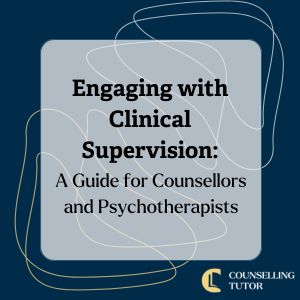
Ken Kelly: Engaging with clinical supervision. So Rory, what is there to know about this?
Rory Lees-Oakes: I think a good start will be to quote from one of the professional bodies, who says that supervision is essential to how practitioners sustain good practice throughout their working life.
And that is a quote from the BACP Ethical Framework, 2018, page 22. And I think it sets a marker that it’s essential. Supervision is essential, and it’s about sustaining you in your practice. The arc of practice for some therapists could be quite a wide one.
They start as students, finding their way, then they move through the arc of practice, becoming more competent, doing more CPD, becoming more reflective and reflexive. And eventually they find themselves in a place where the person you were when you started with your supervisor, that fledgling therapist, is now a more competent, more confident practitioner, and needs a different approach from the supervisor.
And I think my takeaway is, the supervision I had when I started, was very different to the supervision I had when my practice had matured.
Ken Kelly: Yeah, that’s a great point. And, it’s through growth, that’s what we look for when we go to supervision. When we’re looking at supervision, we think of supervision as our practice, but what we’re really doing when we’re choosing a supervisor, is we’re choosing a supervisor for our clients, as well as ourselves, because it’s our clients that we take to our supervisor. And you mentioned growth, Rory, and that growth can come in many different ways.
You wouldn’t expect that if you went to study counselling, that the tutor you had at level two would be the same tutor you would have while graduating your master’s degree. Why? Because you will have different needs at different levels. The same is true when we go into practice, if we are truly growing, we should be reevaluating whether we’re getting the most from our supervision at least annually.
You would expect to gain different things from your supervisor as you grow within your practice, and be challenged differently. And it very much hinges on your client group as well.
So if you’ve done any specific training that opens up a new client group to you, that maybe your supervisor doesn’t have training in, then maybe I need to look to have a second supervisor, or to grow within my supervision and move on from the supervisor I have.
I guess it depends on the person, and I think what you want to avoid from this is supervision becoming a comfortable, lovely place to go because you’ve known the person for so long, and get on really well. Because supervision should, by its very nature, be challenging.
Rory Lees-Oakes: Yeah, absolutely Ken. It’s a professional consultation, and there are lots of models of supervision that supervisors can draw on. The point you make is a really good one that it should fit not only for you at the stage you’re in, but also your clients and the training you’ve done.
During the pandemic, lots of people migrated online, worked online, and there were very few supervisors who had any online and telephone counselling training. But it’s really interesting that if you’re working with a supervisor who has no training in the models that you’re using, whether that’s the delivery model, or whether that’s using a different modality, there’s a danger that your supervisor won’t understand the complexity and completeness of your practice.
And, as you said Ken, we do this in service of our clients, so it’s essential that when you get supervision, they’re supervising the entirety of your practice. And I think that if that isn’t the case, then either take secondary supervision, find the supervisor who has knowledge and expertise in that area, or you just move on and find a different supervisor. Through the years, it’s not unusual for therapists to have two, three, four supervisors. Sometimes they work with two supervisors. Certainly I’ve supervised an EMDR therapist.
So clearly I couldn’t supervise that aspect of her practice, she had a separate clinical supervisor for that. And that was fine, we contracted for it, and she was very happy to have supervision for general practice, which I provided, and specialist supervision for EMDR practice.
Ken Kelly: Yeah, spot on. And I think that when we’re speaking about clinical supervision, it’s to get you thinking about getting the most from your supervision.
Are you being served? Are you serving your clients the best you can through your current supervision? And it’s difficult to evaluate that unless you have a peek behind the Wizard of Oz curtain. Rory and I both trained as clinical supervisors, and indeed in Counselling Tutor we train clinical supervisors. Peeking behind the curtain, there are three main areas, and this is a model from Procter, 1987, suggesting that supervision has three key purposes.
And when you’re in supervision, you’re bringing a client or you’re bringing a challenge that you might have within your practice. See if you can map it to one of these three areas. And they’re called normative, restorative-
Rory Lees-Oakes: restorative. I think it is.
Ken Kelly: I’ll leave you to say the big words.
So normative is maintaining professional standards and monitoring managerial issues. Restorative is support and stress reduction of you, the counsellor. Who are you? How is your wellbeing? Informative is skills and knowledge development. So it’s an educative part of supervision, where your supervisor may say, hey, you know what? From what you’ve brought today, I think you need to go and look at the Equalities Act a little bit deeper, or they might refer you to your ethical framework. So it’s the education side of things.
So in the normative area of supervision is where the supervisor may explore areas of professional practice. And these can include ethical issues, how you might work with them, so this is all under normative, legal issues relating to confidentiality. If you wonder, can I break that confidentiality? Should I break confidentiality? My clients has just said this, that would fall under that, section, and it may also overlap into different sections to, and then issues around complaints might be examined.
They’re supporting your accreditation, if you’re growing within your practice. Restorative, it’s more of a focus on you, who you are and your ability to be well enough to be there for your clients to avoid burnout, to keep your self care routines going.
And it may be Issues around unplanned endings and how they affect you. You might be working with a client, he’s not getting anywhere, this person’s stuck and you just feel it going really round and round in circles. You feel de-skilled, am I good enough for this client? Restorative, the supervisor would work on building you up there and decoding what’s really going on and any struggles you might be experiencing in your day to day life.
And then a formative aspect of supervision refers to the sharing of knowledge and methods that enhance your practice. This is why I said there can be an overlap, because if you maybe had issues around a complaint, or an ethical issue, you may be looking at both normative and formative in the supervision practice there.
Rory Lees-Oakes: Yeah, that’s absolutely correct as the theory goes, Ken. And sometimes it doesn’t appear that you’re going in for normative or restorative or formative consultation. What can happen is that you go into your supervisor and through the one and a half hours that people have in supervision, it can be more, issues arise where it takes you to that place.
So an example may be that a therapist comes in and supervisor says, how’s how things, how’s it going? And they say, I’ve got a client and I just don’t feel skilled enough. I feel de-skilled, it’s not going anywhere.
You would start as a supervisor in the restorative position, you’d be supportive. And I think it’s really good at this point to highlight that restorative is not personal therapy. If it becomes clear within the session as a supervisor that someone’s going through deep personal issues, yes, you can be compassionate. Yes, you could be empathic, but it’s not the place for therapy.
Therapy is a different engagement and it’s done separately outside supervision with a therapist, but to get back to feeling de-skilled, and feeling that you’re not getting anywhere. It can start with restorative being supportive, looking at how to reduce stress, and then there can be that educational part from the supervisor who says, let’s look at the interventions.
What have you been doing? And have you thought of this? Just talking through the client and letting the client live within the session can bring up new awareness. So you might move to formative and then think, actually what the client’s bringing is a bit outside the therapist skill set, they may need some other form of support.
Then you might use the normative to maintain professional standards and say, do you think perhaps the reason you’re struggling with this client, is that you are at the end of your skill set. Which is no shame attached to that, we can’t be everything for everybody, maybe a referral to help this client on, for the benefit of the client, and for the benefits of yourself.
So all those positions within the proctors what we call key purposes, normative, formative, restrictive, they can play out within one and a half hours.
Ken Kelly: Oh, yeah, very much and I also want to say that there’s a lot more to it. That’s not all that you learn on a supervision training course.
It’s like saying that person centred therapy is all about unconditional positive regard, empathy, and not being judgemental. So there’s more to it than that, there is a lot more complexity. But if you break it down, there’s going to be those three areas that you might be touching on regularly throughout the session.
And of course, speaking about getting the most out of supervision, we have to address barriers that may be in the way of you getting the most from your supervision. The first barrier is not having a choice of the supervisor that you work with. You may be in an agency and the agency says we offer supervision, and you’re going to have our supervisor and that’s your choice, you don’t actually have a choice outside of that. That can be a barrier. It might be fine for some, but it might not fit for you.
Supervisor not understanding the supervisor’s modality. So at student level, you will be asked and called on to seek out a supervisor who works in the same modality that you’re studying so that you can be supervised in that modality, and you can understand that
in the early stages of supervision. A much more mature practitioner, may choose a supervisor with a different modality to challenge them in different ways, but you would have to have an understanding of that modality.
And the supervisor would, of course, need some form of understanding of the modality in which you were working. There could be a clash of personalities because that happens everywhere. You can go to a new job. Get a new group of friends and you can say, oh, I really just don’t get on with that person, that can be a barrier to you engaging in supervision at the deepest of levels.
And then I think this one for me, Rory, is by far the one that stands out, and it’s that fear off being judged. And all you need to do is map this to the counselling process where you working with the client, if that client fears that they’re going to be judged or that what they’re bringing to you is not going to be held in confidence, they’re going to be reluctant to engage and you’re probably going to see weaker outcomes in therapy.
And exactly the same is true of supervision. If you’re going in and you’re holding something back, that can be bad for you, for your practice and for your clients and in extreme cases can actually be dangerous, Rory.
Rory Lees-Oakes: It can be very dangerous and I think it speaks to shame in supervision. I think supervision shouldn’t be a telling off. I’ve picked up supervisees who’ve moved their supervisors, and they’ve said, I’ve been told off by my supervisor for doing this.
You don’t tell supervisees off. It’s not a school room where you’re the child and the teachers the adult, you’re two adults. And people do make mistakes, or may have lapses in judgement, but you work through those processes professionally, in an adult way.
And I think if there’s any kind of fear of shame, people will withhold information. And if you’re listening to this and you think, I don’t really like going to my supervisor because I can’t tell them everything. The next question to ask yourself, is this supervisor a good fit for you?
Because if you cannot bring the totality of your practice to supervision, then you need to ask yourself some fundamental questions. One being why is that? And I think that not being able to make full use of clinical supervision ends up with supervisees hiding clients, not speaking about them, leads to not a lot of self challenge or self growth.
And by bringing all of your clients to supervision, even the ones that you feel you’re failing in, and you’re not doing very well with, or you’re not getting along with, that is the area of supervision that’s rich, has the potential for growth, and ultimately has the potential to have a great outcome for your client.
Ken Kelly: Yeah, there’s a voice in me that wants to say, if you’re really struggling with a client, if you’re reluctant to bring a certain client supervision, that’s the one that you should spend the most time in supervision on. Work out what that’s about, what’s causing those feelings within you?
Yeah, so are you getting the most from your supervision or how can you engage with clinical supervision in the best way? Relook at what you’re doing and how you’re working and be honest and truthful and say what works for you, and be honest and truthful and say what doesn’t, and explore that road together.
If it’s the right supervisor for you, you’ll find the way. And this is not to say you’re not getting great supervision at the moment. It’s just this discussion on can we get more out of supervision, engaging with clinical supervision to get the most out of it for our clients.
Rory Lees-Oakes: Yeah, absolutely and that’s what we exist for. We exist to be in service of our clients. If we’re not careful, if supervision becomes too comfortable or avoidant, then we really have to ask ourselves, are we working in service of our clients. Life as a therapist isn’t always an easy road, anybody who chooses to become a therapist, a counsellor, a psychotherapist. It’s not an easy road. Sometimes we have tough, difficult decisions that we need to work out in supervision. To be able to do that, we need to feel safe, confident in our supervisor, and confident in their ability to hold us emotionally. When we may have to make some tricky or difficult decisions.
The normative function focuses on maintaining ethical and professional standards. This involves:
Normative supervision is particularly critical when handling high-risk cases or ethical ambiguities.
Supervision offers a space for emotional and professional support, helping practitioners:
This function ensures that counsellors remain resilient and effective in their roles.
This developmental function includes skill enhancement, CPD opportunities, and reflective practice. Supervisors should help supervisees identify gaps in their knowledge and explore new learning opportunities, encouraging professional maturity.
Practitioners often face challenges that hinder full engagement with supervision, including:
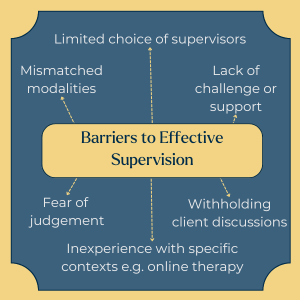
These barriers can result in risk aversion and stunted professional growth. Open communication and mutual trust between the supervisee and supervisor are essential to overcome these challenges.
Supervision needs vary depending on where practitioners are in their professional journey. The developmental model by Hawkins and McMahon (2020) outlines four stages:
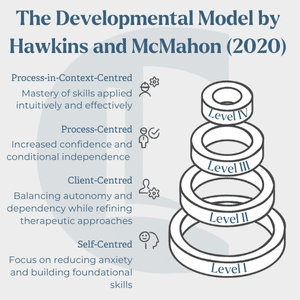
Understanding these stages helps tailor supervision to current needs, promoting confidence and competence.
Understanding where you are in your professional journey is pivotal for effective supervision. Recognising your developmental stage reduces supervision anxiety and provides a clear pathway to growth. As Hawkins and McMahon outline, supervision evolves through the following levels:
Reflect on your stage and discuss it with your supervisor to tailor supervision to your needs.
The COVID-19 pandemic accelerated the shift to online therapy, raising unique supervision challenges:
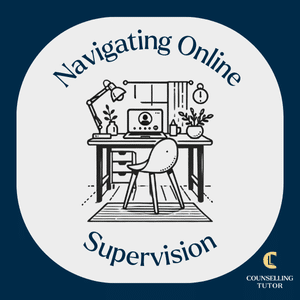
Supervisors must adapt to these changes, ensuring their competencies align with the needs of online practitioners.
Online therapy has introduced unique challenges that require specialised supervision. Supervisors must understand:
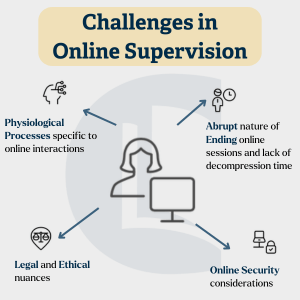
Ethical bodies, such as the BACP, recommend supervision using the same modality as the one used in practice. This ensures alignment between therapeutic methods and supervisory guidance.
Engaging with Clinical Supervision: A Guide for Counsellors and Psychotherapists
Effective supervision also addresses critical areas such as risk and ethics. Managing risk involves identifying and addressing potential harm to clients, the public, or yourself as a practitioner.
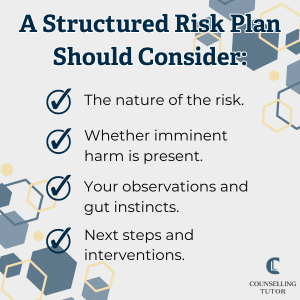
A structured risk plan should consider the following:
A structured risk plan should consider the following:
Incorporating an ethical problem-solving grid allows you to navigate dilemmas methodically. This grid should be a standard part of supervision discussions, enabling defensible and accountable decision-making.
Ethical dilemmas are an inevitable aspect of therapeutic practice, often presenting situations where the right course of action is not immediately clear. To navigate these challenges effectively, counsellors and psychotherapists need a structured approach that promotes clarity, accountability, and defensible decision-making. This is where an ethical problem-solving grid or checklist becomes invaluable.
An ethical problem-solving grid is a structured tool that breaks down decision-making into manageable, logical steps. By systematically addressing each aspect of the dilemma, practitioners can ensure their decisions are well-considered, ethically sound, and documented. This framework safeguards against impulsive or overly subjective choices and helps to align actions with professional standards.
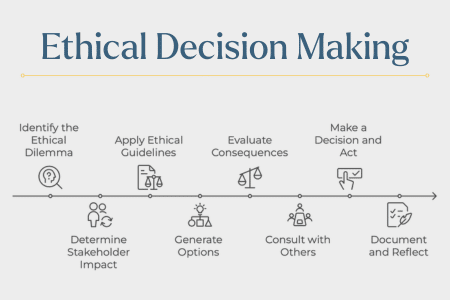
Clearly define the nature of the problem. What specific ethical issue is at play?
For example, is it a confidentiality conflict, dual relationships, or duty of care? A precise understanding sets the foundation for all subsequent steps.
Identify who is affected by the dilemma, including clients, colleagues, organisations, or the wider public. Consider how the issue impacts their rights, well-being, and interests.
Refer to the relevant codes of ethics, such as those from the BACP, ACA, or similar bodies. Highlight specific principles that pertain to the situation, such as autonomy, beneficence, or justice.
Brainstorm possible courses of action. This could range from taking no action to escalating the issue to a higher authority. The aim is to explore all reasonable options without judgement at this stage.
Assess the potential outcomes of each action. What are the risks and benefits for each stakeholder? Are there unintended consequences to consider? This evaluation should include both short-term and long-term implications.
Seek input from supervisors, peers, or ethical committees. Their perspectives can provide invaluable insights and help refine the decision. Supervision, in particular, is a critical space for exploring ethical challenges collaboratively.
Choose the most appropriate action based on the gathered information. The decision should be defensible, meaning it can be justified with a clear rationale grounded in ethical principles and professional standards.
Record the entire process, including the identified dilemma, options considered, consultations undertaken, and the final decision. This documentation ensures accountability and provides a reference for future learning and growth.
| Step | Question | Your Notes |
| Identify the Dilemma | What is the ethical issue? | |
| Stakeholder Impact | Who is affected, and how? | |
| Guidelines Review | What principles or codes apply? | |
| Options for Action | What actions are possible? | |
| Evaluate Outcomes | What are the potential consequences? | |
| Consultation | What do others recommend? | |
| Decide and Act | What is the best course of action? | |
| Document and Reflect | How will you record this process? |
Supervision plays a pivotal role in ethical decision-making. By using an ethical grid collaboratively, supervisors and supervisees can explore dilemmas in-depth, ensuring all perspectives are considered. This process encourages open dialogue, builds professional resilience, and enhances the supervisee’s confidence in managing future challenges.
Engaging with Clinical Supervision: A Guide for Counsellors and Psychotherapists
Clinical supervision fulfils three main functions: normative (upholding professional and ethical standards), restorative (providing emotional support and well-being), and formative (encouraging growth in skills and knowledge). All of which are essential for safe, ethical, and evolving practice.
Common obstacles include limited choice of supervisor, mismatched supervision modality, fear of judgement, or lack of challenge and support. Overcoming these often requires cultivating open communication and mutual trust so that supervision becomes a space for challenge, not just comfort.
Supervision should be tailored to the practitioner’s stage in their professional journey. According to Hawkins & McMahon (2020), developmental stages range from Self‑Centred (early skill-building and anxiety reduction), Client‑Centred, to Process‑Centred (greater confidence and conditional independence), each requiring different supervisory approaches.
Supervision is more than a requirement for ethical practice – it is a transformative opportunity for growth, reflection, and professional excellence. By understanding the foundational pillars of supervision – normative, restorative, and formative – practitioners can engage with the process more intentionally. Recognising barriers to effective supervision and aligning support to developmental stages enables counsellors to evolve confidently and competently.
As the field adapts to modern challenges, such as the rise of online therapy, embracing innovative tools like the ethical problem-solving grid ensures decisions remain grounded in best practices. This structured approach supports accountability and bolsters confidence in navigating complex dilemmas.
Effective supervision nurtures resilience, enhances skill development, and strengthens the therapeutic alliance. Whether you are a new practitioner or a seasoned therapist, actively engaging with supervision ensures that your practice remains ethical, adaptive, and client-focused. Use this guide as a roadmap to deepen your supervisory relationships and unlock the full potential of this vital aspect of your professional journey.
Counselling Tutor provides trusted resources for counselling students and qualified practitioners. Our expert-led articles, study guides, and CPD resources are designed to support your growth, confidence, and professional development.
👉 Meet the team behind Counselling Tutor
Notice any broken link or issues with this resource? Kindly let us know by email
Email us